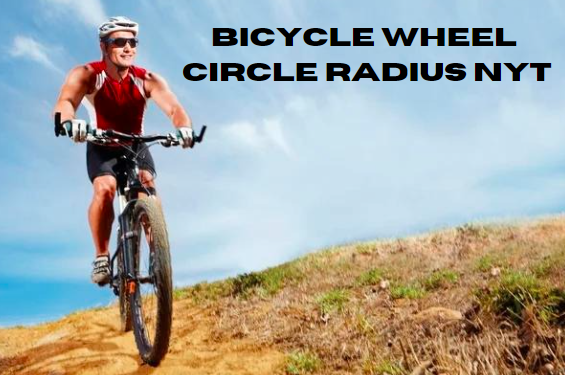Bicycle Wheel Circle Radius NYT: Unlocking the Secret to Optimal Cycling Performance
Introduction
When it comes to cycling, every component of your bike plays a critical role in your overall performance, comfort, and enjoyment. One often overlooked but crucial aspect is the “bicycle wheel circle radius NYT.” Whether you’re a casual rider who enjoys leisurely rides through the park or a competitive cyclist pushing the limits on challenging terrain, the size of your bicycle wheels, specifically the radius, can significantly affect your ride.
Understanding the bicycle wheel circle radius is more than just a matter of technical curiosity; it’s about fine-tuning your bike to your specific needs. This comprehensive guide will delve into what the bicycle wheel circle radius is, why it matters, how it impacts your cycling experience, and how to choose the right wheel size for your needs.
What is the Bicycle Wheel Circle Radius?
The “bicycle wheel circle radius” refers to the distance from the center of the wheel (the hub) to the outer edge of the tire. This measurement is crucial as it directly correlates to the wheel’s diameter and overall size.
In mathematical terms, the radius (r) of a circle is half of the diameter (d), so:
r=d2r = \frac{d}{2}r=2d
For example, if you have a 700c wheel, which is common in road bikes, the diameter of the wheel including the tire is approximately 700 millimeters, making the radius about 350 millimeters.
Importance of Radius in Cycling
The radius of your bicycle wheel plays a vital role in several aspects of cycling, including speed, maneuverability, stability, and comfort. The right wheel size can enhance your riding experience, while the wrong size might hinder your performance.
Common Wheel Sizes and Their Radii
- 700c Wheel: A standard for road bikes, with a radius of approximately 350mm.
- 26-Inch Wheel: Common for mountain bikes, with a radius of about 330mm.
- 650b Wheel: Found in some gravel and mountain bikes, with a radius around 335mm.
- 29er Wheel: Popular in mountain biking, especially in cross-country disciplines, with a radius of approximately 370mm.
Understanding the different sizes and their corresponding radii helps you make informed decisions when customizing or purchasing your bike.
The Science Behind Bicycle Wheel Circle Radius and Cycling Performance
Speed and Acceleration
One of the most critical aspects influenced by wheel size is speed. Larger wheels have a greater circumference, meaning they cover more ground with each rotation. This characteristic can result in higher speeds, especially on flat terrain. However, larger wheels also require more effort to accelerate from a standstill due to their increased rotational inertia.
Maneuverability and Handling
Smaller wheels generally offer better maneuverability. A smaller radius means the wheel has less rotational mass, making it easier to change direction quickly. This is particularly advantageous in technical riding situations, such as mountain biking on narrow, twisty trails.
Stability and Control
Larger wheels provide more stability, especially at higher speeds. The larger contact patch with the ground improves grip, which is why many cyclists prefer larger wheels for downhill and cross-country mountain biking. However, the increased stability comes at the cost of maneuverability.
Comfort
The wheel size and radius also affect ride comfort. Larger wheels can roll over obstacles more smoothly, reducing the impact of bumps and uneven surfaces. This characteristic makes them ideal for long-distance touring and riding on rough terrain.
Climbing Efficiency
When it comes to climbing, smaller wheels might offer an advantage due to their lower rotational mass. They are easier to spin up to speed, which can be beneficial on steep inclines. However, the difference is often marginal and can be outweighed by the overall bike setup and rider strength.
Choosing the Right Bicycle Wheel Circle Radius for Your Needs
Road Cycling
For road cyclists, the 700c wheel size is the most common due to its balance between speed and stability. The 700c wheels have a radius of approximately 350mm, making them well-suited for long rides on smooth pavement. They offer a good mix of efficiency and comfort, allowing riders to maintain higher speeds over long distances.
Pros:
- Faster speeds on flat terrain
- Stable at high speeds
- Comfortable on smooth surfaces
Cons:
- Less maneuverable
- Harder to accelerate from a stop
Mountain Biking
Mountain bikers often prefer 26-inch, 650b, or 29er wheels, depending on their riding style and terrain. The 26-inch wheels have a smaller radius, making them more agile and easier to maneuver through technical trails. The 29er wheels, with a larger radius, are preferred for their stability and ability to roll over obstacles with ease.
26-Inch Wheels
- Pros: Highly maneuverable, quick acceleration.
- Cons: Less stable, slower on flat terrain.
29er Wheels
- Pros: Superior stability, rolls over obstacles easily.
- Cons: Heavier, less maneuverable in tight spaces.
Gravel and Cyclocross
For gravel and cyclocross bikes, the 650b wheel size is becoming increasingly popular. With a radius slightly smaller than 700c wheels, 650b wheels strike a balance between road cycling efficiency and off-road capability. They allow for wider tires, which improve grip and comfort on rough terrain.
Pros:
- Versatile for mixed terrain
- Allows for wider tires
- Balanced speed and comfort
Cons:
- Slower on smooth pavement compared to 700c
- Less stable than 29er wheels on rough terrain
Urban and Commuter Bikes
Urban and commuter bikes often use a variety of wheel sizes, but 700c is common due to its efficiency in city environments. Smaller wheels, like 26-inch, can be found on folding bikes, offering easy storage and nimble handling in tight spaces.
Pros:
- Efficient for city commuting
- Easy handling in urban environments
- Good balance between speed and comfort
Cons:
- Less comfortable on uneven surfaces
- Larger wheels can be cumbersome in crowded areas
The Impact of Tire Width on Bicycle Wheel Circle Radius
Tire Width and Rolling Resistance
The tire width also plays a significant role in the performance of your bicycle wheels. Wider tires generally offer more comfort and better grip, but they can also increase rolling resistance, which can slow you down on smooth surfaces. Narrower tires, on the other hand, reduce rolling resistance, making them ideal for high-speed road cycling.
Effect on Radius
The actual radius of your bicycle wheel can change slightly depending on the tire width. A wider tire increases the overall diameter of the wheel, thus slightly increasing the radius. This change is typically minimal but can have an impact on the ride characteristics, especially in terms of comfort and grip.
Balancing Act: Choosing the Right Tire Width
When choosing the right tire width, it’s essential to consider the type of riding you’ll be doing most often. For road cycling, narrower tires (23mm to 28mm) are generally preferred for their low rolling resistance and high speed. For gravel and off-road riding, wider tires (35mm to 50mm) provide better traction and comfort.
How to Measure Your Bicycle Wheel Circle Radius
Tools You’ll Need
- A tape measure or a ruler
- A flat surface
- A marker (optional)
Step-by-Step Guide
- Remove the Wheel from the Bike: To get an accurate measurement, it’s best to remove the wheel from the bike.
- Measure the Diameter: Place the wheel on a flat surface. Using a tape measure, measure the distance from one side of the tire to the other across the center of the wheel.
- Divide by Two: The radius is half of the diameter. Divide the diameter by two to find the radius.
- Consider the Tire: If you’re measuring the radius with the tire on, remember that different tire widths can affect the measurement slightly.
Why Accurate Measurement Matters
Accurate measurement of your bicycle wheel circle radius is essential for selecting the right tires, optimizing your bike’s performance, and ensuring compatibility with your bike’s frame and components.
Bicycle Wheel Circle Radius NYT: Innovations and Trends
Tubeless Tires and Their Impact on Radius
The advent of tubeless tires has changed the dynamics of bicycle wheels. Tubeless setups allow for lower tire pressures, which improves grip and comfort without the risk of pinch flats. The ability to run lower pressures with tubeless tires slightly increases the tire’s contact patch, effectively changing the radius and improving ride quality.
Carbon Fiber Wheels
Carbon fiber wheels are becoming increasingly popular due to their lightweight and aerodynamic properties. While the material doesn’t directly change the radius, it affects the wheel’s overall performance. Carbon fiber wheels, especially in larger diameters, can maintain high speeds with less effort, making them a favorite among competitive cyclists.
The Future of Bicycle Wheel Design
As technology advances, we can expect to see continued innovation in bicycle wheel design. Potential developments include wheels with adjustable radii, where the rider can modify the wheel size on the go to adapt to different terrains and riding conditions. While this technology is still in its infancy, it represents an exciting frontier for cyclists looking to optimize every aspect of their ride.
Frequently Asked Questions (FAQs)
What is the best bicycle wheel radius for road cycling?
The most common wheel radius for road cycling is around 350mm, which corresponds to a 700c wheel. This size balances speed, stability, and comfort, making it ideal for long-distance rides on smooth pavement.
How does wheel radius affect climbing?
Smaller wheels with a shorter radius can offer a slight advantage in climbing due to their lower rotational mass, which makes them easier to accelerate uphill. However, the overall impact is minimal compared to factors like rider strength and bike setup.
Can I change the radius of my bicycle wheels?
You can effectively change the radius by switching to different wheel sizes or by changing the tire width. However, ensure that your bike frame and components are compatible with the new wheel size to avoid issues.
What is the impact of tire width on wheel radius?
Wider tires slightly increase the overall diameter and radius of your wheels. This change can improve comfort and grip but may also increase rolling resistance, affecting your speed on smooth surfaces.
Are larger wheels always better for stability?
Larger wheels generally provide better stability, especially at high speeds and on rough terrain. However, they can be less maneuverable, making them less ideal for technical riding situations where quick direction changes are needed.
Conclusion: Mastering the Bicycle Wheel Circle Radius NYT
Understanding and optimizing the “bicycle wheel circle radius NYT” is key to enhancing your cycling experience. Whether you’re aiming for speed, comfort, or versatility, the right wheel size and radius can make all the difference. By considering your riding style, terrain, and personal preferences, you can select the optimal wheel setup that meets your needs and elevates your performance on the road or trail.
As cycling technology continues to evolve, staying informed about the latest trends and innovations in wheel design will help you stay ahead of the curve, ensuring that every ride is as enjoyable and efficient as possible.






